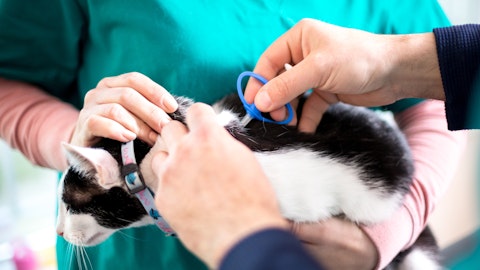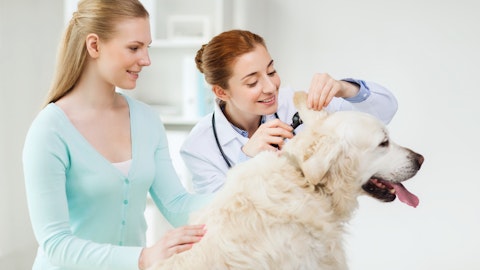Zoetis Inc. (NYSE:ZTS) Q3 2023 Earnings Call Transcript November 2, 2023
Zoetis Inc. beats earnings expectations. Reported EPS is $1.36, expectations were $1.35.
Operator: Welcome to the Third Quarter 2023 Financial Results Conference Call and Webcast for Zoetis. Hosting the call today is Steve Frank, Vice President of Investor Relations for Zoetis. The presentation materials and additional financial tables are currently posted on the Investor Relations section of zoetis.com. The presentation slides can be managed by you, the viewer, and will not be forwarded automatically. In addition, a replay of this call will be made available approximately 2 hours after the conclusion of the call via dial in or on our Investor Relations section of zoetis.com. [Operator Instructions]. It is now my pleasure to turn the floor over to Steve Frank. Steve, you may begin.
Steve Frank: Thank you, operator. Good morning, everyone, and welcome to the Zoetis third quarter 2023 earnings call. I am joined today by Kristin Peck, our Chief Executive Officer; and Wetteny Joseph, our Chief Financial Officer. Before we begin, I’ll remind you that the slides presented on this call are available on the Investor Relations section of our website, and that our remarks today will include forward-looking statements and that actual results could differ materially from those projections. For a list and description of certain factors that could cause results to differ, I refer you to the forward-looking statements in today’s press release and our SEC filings, including, but not limited to, our annual report on Form 10-K and our reports on Form 10-Q.

Baronb/Shutterstock.com
Our remarks today will also include references to certain financial measures, which were not prepared in accordance with generally accepted accounting principles or U.S. GAAP. A reconciliation of these non-GAAP financial measures to the most directly comparable U.S. GAAP measures is included in the financial tables that accompany our earnings press release and the company’s 8-K filing dated today, Thursday, November 2, 2023. We also cite operational results, which exclude the impact of foreign exchange. With that, I will turn the call over to Kristin.
Kristin Peck: Thank you, Steve. And welcome, everyone, to our third quarter earnings call for 2023. We generated strong performance in the third quarter, driven by our diverse companion animal portfolio of key dermatology products, pet parasiticides, monoclonal antibodies for osteoarthritis pain and diagnostics. We delivered 8% operational growth in revenue and 13% operational growth in adjusted net income, despite continued market challenges in China. We showed balanced segment growth this quarter with 8% operational growth internationally, and 8% growth in the U.S. Our companion animal portfolio grew 11% and our livestock portfolio grew 3% operational — operationally in 3Q, in line with our overall expectations. Through the first nine months of the year, we have grown our revenue 7% operationally, as customers place a premium on the animal health benefits that our products delivered, even in times of economic and geopolitical uncertainty.
As the market leader in animal health, we compete in an essential global industry that has been resilient during various economic cycles. And we continue growing above the market based on a steady pipeline of new products, lifecycle innovations, and commercial execution. We are on track to achieve our full year operational guidance and have narrowed it around the midpoint of the range, as we continue to balance headwinds and tailwind in the marketplace. We are executing well on the drivers where we have more control, like the successful launch of Librela in the U.S., while also mitigating the downside of macroeconomic declines in China, both of which were not considered in our original guidance this year. Once again, our diverse portfolio across product categories and geographies generate durable, reliable long term growth.
We continue to expect our key companion animal franchises to be our core catalysts for growth. We anticipate strong growth and our market leading dermatology portfolio for the year, building on the ongoing direct to consumer or DTC digital campaigns that support disease and product awareness. As well as the continued introduction of life cycle innovations like Apoquel Chewable. Our compare to franchise and broader portfolio of parasiticides continue to perform well in this increasingly competitive product category, based on our innovative and highly effective products and promotional support from DTC. In terms of new products, we’re very pleased with the U.S. launch of Librela, our canine monoclonal antibody for osteoarthritis or OA pain. This product has been very well received by veterinarians and pet owners in the U.S., as well as other major markets globally.
And we have built ample supply for continued growth in the U.S. and elsewhere. Solensia, our monoclonal antibody for OA paining cats has also been well received by veterinarians in markets around the world. As we look to help increase medicalization of cats. We’re building awareness of this condition among cat owners, and introducing our monoclonal antibody treatment through DTC campaigns, as well as AI tools like cat pain IQ, which helps that and pet owners use videos to identify this condition. Our diagnostic portfolio has been showing stronger year-over-year performance in 2023, with 14% operational growth in the third quarter, and we continue to refine this business to better serve customer needs across our comprehensive portfolio. For example, we’re simplifying our reference lab service and operating model in the U.S. and focusing on expanding our larger regional hubs, which can deliver one-day turnaround and have more modernized operations.
We also continue to emphasize the benefits of AI technology and our virtual lab services to enhance the speed and quality of our diagnostic solutions. With all this in mind, we are narrowing our full year guidance for operational growth to a range of 6.5% to 7.5% in revenue and a range of 7.5% to 8.5% in adjusted net income, keeping the same midpoint as our prior guidance. Wetteny will provide more details on guidance in his remarks. We continue to see strong underlying customer demand this year and into 2024, even while recovery in China is still a notable uncertainty. The majority of that practices in the U.S. continue to see high customer demand for veterinary services. However, labor constraints and more limited hours continue to hamper their ability to meet this demand.
Year-to-date, clinic visits are flat as we expected. We did see a modest decline in clinic visits this quarter in the U.S., while clinic visit revenues and average revenue per visit were up. Looking ahead, we remain confident in the sustainable underlying demand for animal health, based on the strength of the human animal bond, people’s willingness to spend on pet house and the essential need for safe and secure food supply. We expect to achieve double digit operational growth for our companion animal portfolio this year and low single digit operational growth in our livestock portfolio. Before I wrap up, I want to reiterate a theme I discussed earlier this year at Investor Day. It’s the confidence we have in sustaining our key market leading franchises across dermatology, pet parasiticides and osteoarthritis pain based on life cycle innovations in these categories as well as the pipeline we are exploring in other areas of unmet need.
We are firmly committed to investing in our portfolio as well as the DTC programs and capabilities we need to support our growth, while managing costs and creating value for our shareholders. Despite economic and geopolitical uncertainties in China and elsewhere, we believe we will continue to grow faster than the market for the remainder of 2023 and into 2024. This confidence stems from our diverse portfolio across markets and species. Our industry-leading franchises, the ongoing launch of Librela and the operational excellence and agility that our people deliver every day for our business and for our customers. So thank you, and let me hand this over to Wetteny. Wetteny?
Wetteny Joseph: Thank you, Kristin, and good morning, everyone. As Kristin mentioned, we had a strong third quarter, with broad-based growth across both our U.S. and international segments across both companion animal and lifestyle portfolios and across both price and volume. For the quarter, we were able to deliver results in line with our expectations, even in light of continued headwinds in China. In the third quarter, we generated revenue of $2.2 billion, growing 7% on a reported basis and 8% on an operational basis. Adjusted net income of $629 million grew 11% on a reported basis and 13% on an operational basis. Of the 8% operational revenue growth, 5% is from price and 3% is from volume. Volume growth consisted of 2% from new products, including our monoclonal antibodies for pain, Librela and Solensia and 1% from our key dermatology portfolio.
Our companion animal portfolio was the main driver of revenue growth, growing 11% operationally. Livestock also contributed, with operational growth of 3% in the quarter. Companion animal growth was again driven by our innovative products with double-digit operational growth in our key dermatology portfolio, our monoclonal antibodies for OA pain, Librela and Solensia and Simparica Trio. Our key dermatology products generated $393 million in sales globally, posting growth of 14% on an operational basis with double-digit growth in both the U.S. and international. Globally, our monoclonal antibodies for OA pain posted $77 million in combined revenue in the quarter. Growth came primarily from our European markets as well as from the impact of new launch markets internationally.
With the October full launch of Librela in the U.S., our pain products are now available in most major markets. Simparica Trio posted global revenue of $206 million in the quarter, representing growth of 20% operationally versus the comparable 2022 period. Growth was driven by expanded DTC advertising support globally as well as from increased field force and promotional focus. Our companion animal diagnostics portfolio reported revenue of $90 million and grew 14% operationally, with growth contributions from both the U.S. and international. Our life sci portfolio grew 3% operationally, with international growth partially offset by a slight decline in the U.S. Growth in livestock was driven primarily by price, especially in high inflationary markets.
We also saw volume growth in our poultry portfolio, driven by increased usage of vaccines as well as our antioxodio product, Zoamix in the U.S. Now moving on to revenue growth by segment for the quarter. U.S. revenue was $1.2 billion in the quarter, growing 8%, with companion animal products growing 11% and livestock sales declining 2%. On the companion animal side, while vet clinic visits declined 1.5% in the quarter, we continue to see robust play in revenue growth, up 6% versus a year ago. Average revenue per visit is up over 7%. On a year-to-date basis, clinic visits are flat, while clinic revenue is growing 8%. These trends highlight the continued durability of pet owner willingness to spend as well as the continued impact of vet clinic staffing challenges.
Our companion animal revenue growth continues to outpace veterinary clinic revenue growth, due in part to our continued upsized growth in retail channel. Turning to product performance. Companion animal growth in the U.S. was driven by our key dermatology portfolio, Simparica Trio and Solensia. Key dermatology product sales in the U.S. were $260 million in the quarter, growing 13%. Simparica point sales continued to drive growth in the quarter, with vets showing a preference for injectables due to higher compliance and pet owners appreciating the longer duration of treatment. Apoquel sales were driven by growth in the retail channel as pet owners continue to rely more heavily on retail for ongoing pharmacy needs as well as retail auto ship programs that drive higher compliance.
Our latest dermatology life cycle innovation at Apoquel Chewable was launched in the U.S. in October. Apoquel Chewable has been well received in Europe, as pet owners favor the ease of chewable administration over film-coated tablets. Simparica Trio posted U.S. sales of $184 million in the quarter, growing 17%, driven by increased focus in our parasiticide promotional programs. We continue to see patient share growth in Simparica Trio, even with the recent competitive launch in the triple combination space. We remain confident in our ability to compete through our superior label, strong retail channel presence, and the strength of our corporate and specialty relationships. In the U.S., our pain products posted sales of $15 million in the quarter.
We continue to see solid player penetration growth for Solensia, as well as an uptick in Feline clinic visits and expect to continue to drive awareness of Feline OA through our DTC advertising campaigns. Librela has been well received by early experience program participants and their patients during the third quarter. We moved to a full launch in mid-October. We have been very pleased with post launch performance thus far, and are confident that we have ample supply to meet our demand expectations. Our U.S. companion animal diagnostics portfolio posted growth of 18% in the quarter, as we continue to see positive results from the new field force we introduced last year. We saw strong placement growth in the quarter, especially on our images device.
U.S. livestock sales declined 2% in the quarter, primarily resulting from the timing of supply on certain cattle products in the prior year, where we had an improved supply position and restocking in the channel, which drove a strong comparable quarter. The Q3 decline was partially offset by growth in our cattle productivity implant, Synovex due to extended label claims. The cattle decline was partially offset by growth in poultry due to vaccines and the extended use of Zoamix, an alternative to antibiotic medicated feed additives. Moving on to our International segment, where revenue grew 8% on both a reported and operational basis in the quarter. International companion animal revenue grew 12% operationally and livestock grew 5% operationally.
Increased sales of companion animal products resulted from growth in our monoclonal antibodies for OA pain, our key dermatology products and our small animal parasiticides portfolio. Growth in our OA pain products was bolstered by field force focus and DTC awareness campaigns in early launch European markets, specifically the U.K. and Germany, as well as the continued uptake in markets launched earlier this year. Librela sales were $50 million international or 55% operational growth in the quarter, despite a slightly more difficult comparator in Q3 of 2022 due to the removal of supply constraints in our international markets. We remain confident in our ability to supply our forecasted demand for Librela. Solensia sales were $12 million in the quarter.
Our international key dermatology portfolio contributed $133 million of revenue and grew 17% operationally. We saw double-digit growth across most of our major markets and strong uptake of Apoquel Chewable. Apoquel growth was driven primarily by the delayed itch season in Europe and Canada. Cytopoint growth was driven by continued patient expansion and higher compliance in existing patients. Our international small animal are parasiticides portfolio growth of 9% operationally was driven by our Simparica franchise, with Simparica posting $40 million in revenue, growing 29% operationally, driven primarily by demand generation in emerging markets. Simparica Trio posted $23 million, growing 47% on an operational basis, driven by growth in corporate account contracts.
The Simparica franchise performance was partially offset by a 16% operational decline in Revolution franchise, driven by a difficult comparable period in China, due to the return of supply in the prior year as well as the ongoing impact of the current economic conditions. As Kristin mentioned, we have seen declines in China due to the ongoing economic challenges, particularly on the companion animal side, which were not fully reflected in our initial guidance. We continue to monitor economic conditions. However, we are not expecting an improvement this year or into the first half of next year. Our international livestock segment grew 5% operationally in the quarter, driven primarily by price increases, especially in high inflationary markets.
Growth was driven primarily by our cattle portfolio, which grew 8% operationally. Brazil was the largest contributor, where we have seen price growth, supply recovery on certain products as well as continued improvement in cattle industry dynamics. Additionally, the prior was a weak comparative period due to the impact of supply disruptions and a more uncertain industry dynamic led to a lowering of channel inventories in the quarter. Our poultry business also contributed to growth in the quarter, growing 9% operationally due to increased key account penetration in emerging markets. Now moving on to the rest of the P&L for the quarter. Adjusted gross margin of 70.5% improved 70 basis points on a reported basis compared to the prior year, primarily driven by the impact of price increases and lower freight charges.
This was partially offset by higher manufacturing costs, inventory charges and product mix. Adjusted operating expenses increased 7% operationally, driven primarily by higher SG&A expenses, which were 5% operationally due to higher competition related expenses. R&D expenses grew 13% on an operational basis in the quarter, driven by higher compensation-related expenses as well as increased project spend for our pipeline projects. The adjusted effective tax rate for the quarter was 19.6%, a decrease of 130 basis points due to favorable jurisdictional mix of earnings and a higher benefit in the U.S. related to foreign-derived intangible income, partially offset by lower net discrete tax benefits. And finally, adjusted net income was 13% operationally and adjusted diluted EPS grew 15% operationally for the quarter.
Capital expenditures in the third quarter were $145 million. We now expect full year capital expenditures to be in the range of $725 million to $750 million. In the quarter, we repurchased $250 million of Zoetis shares. Now moving to guidance for the full year 2023. Please note that guidance reflects foreign exchange rates as of late October, which reflect the continued strengthening of the U.S. dollar. Beginning with revenue for the full year. Due to unfavorable foreign exchange rates, we are revising our reported revenue range while narrowing our guidance on operational revenue growth. We expect revenue between $8.475 billion and $8.55 billion, with a range of 6.5% to 7.5% operational growth. Our previous guidance was 6% to 8%. We have been pleased with our operational performance thus far.
While foreign exchange headwinds have been larger than expected, our year-to-date operational revenue growth of 7% is in line with our expectations. We expect to benefit from the approval and launch of Librela in the U.S., which is included in our revised guidance last quarter as well as the performance of our Lifestyle business. However, ongoing uncertainty in China has continued to offset upside potential. We are expecting adjusted net income to be in the range of $2.49 billion to $2.51 billion, also slightly lower, driven by unfavorable foreign exchange. Operationally, we are narrowing our growth expectations to a range of 7.5% to 8.5%, previously 7% to 9%. Expected reported diluted EPS narrows to a range of $5.14 to $5.21. And adjusted diluted EPS narrows to $5.38 to $5.43.
Finally, to summarize before we go to Q&A. Our broad-based growth across species and geographies despite the challenging economic environment in China, continue to highlight the resilience of our portfolio and of the animal health industry. We remain committed to growing above the industry, driven by our innovative portfolio, commercial execution and multiple sources of in-line growth. Now I’ll hand things over to the operator to open the line for your questions. Operator?
See also 12 Best Micro Cap Stocks To Invest In and 20 Cheapest Beach Towns to Live in the World.
Q&A Session
Follow Zoetis Inc. (NYSE:ZTS)
Follow Zoetis Inc. (NYSE:ZTS)
Operator: [Operator Instructions] We’ll take our first question from Jon Block with Stifel. Please go ahead.
Jon Block: Great, thanks guys. Good morning. I promise one long question. So in companion animal, the overall revenue was a bit shy of what we had expected, but you really had great performance what we call sort of the big 5 products. So atopic derm, Trio map, the big 5 were all ahead of our estimate. So maybe if you guys can talk a little bit about the ongoing uptake of some of those key big 5 products even with a more difficult consumer, right? Because people view some of those as discretionary. Again, the results were really strong and even despite the more difficult consumer. And then the flip side would just be like anything to site regarding the legacy products, right? So if you back into legacy that might have been modestly down year-over-year.
And a quick part B on the follow-up, Kristin, you mentioned faster growth for Zoetis than market and get in ’24. I don’t think we’re really surprised by that. You’ve done that year in and year out. But can I push you a little bit on how we should think about for Zoetis in ’24 versus Zoetis in ’23? In other words, if we take into account the OA pain uptake, if you would, could we see accelerated growth for the company in ’24 versus ’23 when we think about all the moving parts?
Kristin Peck: Wow. Okay. So John, great question. I think there’s like 20 questions on that one. So I don’t know how we would do that, but let me start, and then I’ll let Wetteny build on it. To your point, we had really strong growth across our franchises. And if you look at dermatology, it’s 14% in the quarter, Paris [ph] at 10%, diagnostics at 14% and the overall pain portfolio at 91%. So there really was strong growth across all those. Obviously, leading the growth there will be pain. And as you look into 2024, we see that as well with significant optimism about where that’s going to go, we’re very pleased with where that launch is. These are both Librela and Solensia, 2 products that are very early in their life cycle with significant growth.
And I think if you really double click if you look at international, who already have these products in the market for a while, you’re seeing great growth. Importantly, we’re continuing to see really strong compliance on those products across Europe. As someone who currently has a dog who has an early experience, who look at their second dose of Librela, the difference that it makes, I really can’t see any pet owner taking their dogs off these world-leading medications. So maybe Wetteny, if you want to take on some of the detailed questions you had around derm, paris and Solensia. But to your point, we remain very optimistic looking into 2024 about the strength of our companion animal portfolio and the 11% was in line with what we expected to be honest.
But Wetteny, do you want to give more detail on some of that?
Wetteny Joseph: Yes, absolutely. Look, the 11% growth operationally in companion animal is right in line with our expectations coming into the quarter. And the overall growth of 8% operational, I would even say, is slightly above. If you recall on the last call, we said expect Q3 to come in somewhere between the mid and the high end of our growth rate. So that’s roughly between 7% and 8%, so at the high end of that. But in terms of consumer, look, as we’ve said time and time again, if you look at the therapeutics category in terms of the value in pet health as well as some of the chronic conditions, as Kristin mentioned, consumers have not been treating those as discretionary. Even when you see some relative softness in pet spend, it doesn’t carry over into the health care piece in terms of therapeutics, et cetera.
And we’ve seen that play out in many ways even as I’m sure we’ll get into a — clinic visits are slightly down in the quarter. Clinic revenue is up almost 7%, and we’re growing faster than that. Again, retail being a part of that, and we’ll get into that in a little bit more detail. When I look at the big products, as you described them, John, derm, Triomabs, all up double digits and up across U.S. and international. I mean our growth this quarter was broad-based, across companion animal livestock U.S. international price, 5% volume on 3%. So really broad-based. And I think that really underscores the breadth of our products as well as our innovation and the value that consumer and pet owners place on products. The legacy products, when I look at in line, keep in mind, when we talk price, we tend to see price lift in those legacy products as well.
But when it volume, it wasn’t down. In-line products were actually flat on the quarter year-on-year with some lift on price. So hopefully, that helps. But I share the optimism Kristin described with respect to 2024. I mean we have multiple sources of growth, not only the Librela launch in the U.S. You’ve got continued growth across international markets for Librela and Solensia as well. And of course, we’ll have price as a lever in addition to in-line products we just talked about. Livestock is now back to growth, and we’ll look at what that looks like when we come back with guidance next year. And then we expect growth across our key franchises as well in terms of derm, paris and diagnostics. So I’ll cap it there as a long answer to a long question, but we’ll take the next one.
Operator: Certainly, we’ll take our next question from Erin Wright with Morgan Stanley.
Erin Wright: Thanks. On Librela, can you talk a little bit about the initial feedback for U.S. practices? Will there be any initial clinic level stocking? I think you said your expectations are intact there. But any lumpiness quarter-to-quarter that we should be thinking about? Has anything changed in terms of your expectations there? And then as we think about margin expansion next year, given Librela won’t be at critical mass so that we may weigh on the gross margin. But is there still some underlying operating leverage that we should think about across the business?
Kristin Peck: Sure. Thanks, Erin. I’ll take the first half of the question, and Wetteny can take the second half of the question. We launched in the U.S., the early experience trial in September with 400 clinics. As I mentioned, my dog puppy was actually one of those dogs. We went to a full launch in mid-October once we got a full dose in, and that’s really the uptake was really strong. Very pleased with the results. We’re obviously still in the early stages, but we’re seeing it very similar to what we saw in Europe. Both vets and pet owners are super excited. We make sure that we’ve got ample supply as both Wetteny and I mentioned, because we do see this as a strong ramp, as you saw what happened in international. International had a supply constraint for a while.
And as soon as we open that, we saw where that really went. So we continue to see really strong demand. Penetration is going really well in the clinics in the U.S. and the experience is broadening. There will be some small initial stocking for sure in some of those clinics, but I don’t know if I would call that lumpiness going into next year. There definitely was obviously, they stock it. And our hope is we continue to just continue to drive that growth going forward. It is the number 1 selling OA pain product in Europe. We expect it to obviously be the same in the U.S. If you look at the U.S. in particular, Erin, there are 26 million medicalized dogs with OA. So this is a big market that we’re going after, and this is a game-changing product.
So we really see a very strong potential with this. We think Librela will expand the market. And as we’ve mentioned before, we really do think Librela and Solensia alone can be a $1 billion portfolio for us. And that’s in a market today that was only $400 million. So I think that sort of underscores where we see growth there. But do you want to talk about the margin expansion issue, Wetteny?





